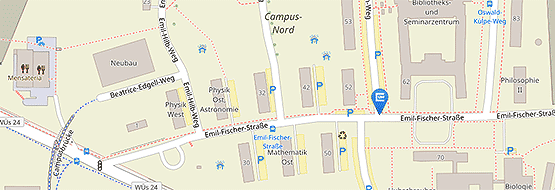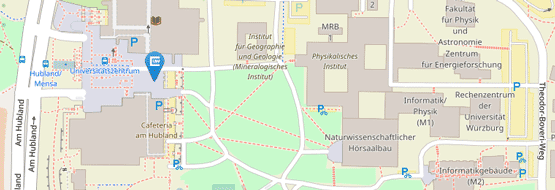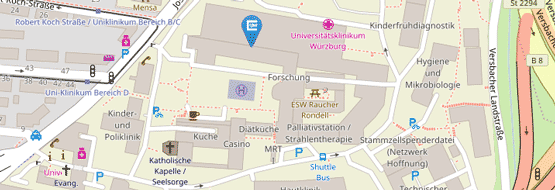When Action Plans and Movements are Slowed Down
10/21/2025People suffering from schizophrenia often have problems with thinking and movement. A new study by Würzburg University Medicine has now discovered the causes of this.

Around one percent of the population will develop schizophrenia in the course of their lives, a severe mental illness characterised by disorders of thought, perception, emotions and often also behaviour. Although schizophrenia cannot be cured, it is now easily treatable with medication and psychotherapeutic therapies.
In around 80 per cent of those affected, however, motor disorders occur independently of the side effects of antipsychotics. In every second person affected, movements and thought processes are slowed down. "Everything they do is slower, sometimes so much so that they can no longer cope with everyday life on their own," says Professor Sebastian Walther, Director of the Clinic of Psychiatry, Psychosomatics and Psychotherapy at the University Hospital of Würzburg (UKW). Motor disorders in psychiatric illnesses are one of his main areas of research.
No Motor Homunculus in the Brain
"For more than a hundred years, it has been assumed that every muscle in the body is controlled via a fixed point in the cerebral cortex. However, the representation of this so-called motor homunculus, in which each body part is assigned an area in the cerebral cortex, is too simplistic and inadequate," reports Sebastian Walther.
Two years ago, US researchers used high-resolution imaging to discover that specialised regions for certain body parts alternate with intermediate areas in the motor cortex. These are not responsible for a single muscle, but integrate movement planning, coordination and signals from the body. Control in the brain is therefore not a linear structure, but a pattern of "effector zones" and "integration zones".
Mapping Psychomotor Behaviour in the Brain
"These integrative zones responsible for complex movements are most likely involved in the movement abnormalities of our patients," says Sebastian Walther early on. He formulated his hypothesis a short time later in the medical journal JAMA Psychiatry. And he has now been able to prove the functional organisation of the primary motor cortex in psychoses and the potential role of intereffector regions in psychomotor slowing in the scientific journal PNAS (Proceedings of the National Academy of Sciences).
Before Walther became Clinic Director in Würzburg in October 2024, he was Deputy Clinic Director and Chief Physician at the University Clinic for Psychiatry and Psychotherapy in Bern. There, he and his team analysed functional MRI images of 126 patients diagnosed with schizophrenia and 43 healthy individuals.
Firstly, he was able to replicate what his US colleagues had published two years earlier. In the second step, the researchers created a contrast and compared the functional connectivity of the brains of people with psychosis with that of healthy people. In the third step, they contrasted patients whose psychomotor function was slowed with those who had no psychomotor impairments.
The Greater the Slowdown, the Greater the Change in the Cortex
"We have seen that the changes are not related to schizophrenia per se, but are only found in patients whose movements are slowed down. In these patients, the regions within the motor cortex were linked differently," summarises Sebastian Walther.
Together with his team, he examined brain activity for ten minutes in a resting state and then analysed which areas of the brain communicate with each other and oscillate at the same frequencies. "The differences were already significant here," says Walther. But how strongly are these changes linked to behaviour? "Very strongly," he answers. "The greater the slowdown, the greater the change in the primary motor cortex."
The daily amount of movement was measured using a fitness tracker, while fine motor skills were measured using a dexterity test in which the patients rotated a coin between their fingers.
Magnetic Pulse Training for the Brain
What do these research results mean in concrete terms for patients? There is a great deal of suffering for those whose movements and action planning are severely slowed down. Pharmacological treatments are not yet available. Transcranial magnetic stimulation (TMS) offers hope. Sebastian Walther has already successfully trialled this method in a study with patients with severe slowness of movement.
In TMS, short magnetic pulses are transmitted to the brain from the outside through the skull in order to influence the disturbed brain activity and rebalance networks. The group that received targeted magnetic stimulation became significantly more mobile and showed the greatest improvements, while the other groups that received placebo TMS or no treatment at all showed hardly any changes.
However, the study still targeted the premotor cortex, an area further forward in the frontal lobe that plans and coordinates movements before they are executed. "With the new information from the current PNAS publication, we might be able to target the intereffectors within the primary motor cortex more precisely," says Walther. That would be a next research project.
To strengthen his research team, he has now been able to recruit neuroscientist Dr Stéphanie Lefebvre for the UKW. The neuroscientist was a postdoc in Walther's research group in Bern and is the last author of the current PNAS publication.
Original publication
S. Walther, F. Wüthrich, A. Pavlidou, N. Nadesalingam, S. Heckers, M.G. Nuoffer, V. Chapellier, K. Stegmayer, L.V. Maderthaner, A. Kyrou, S.von Känel, & S. Lefebvre, Functional organisation of the primary motor cortex in psychosis and the potential role of intereffector regions in psychomotor slowing, Proc. Natl. Acad. Sci. U.S.A. 122 (42) e2425388122, https://doi.org/10.1073/pnas.2425388122 (2025).






